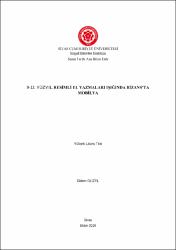9-12. Yüzyıl Resimli El Yazmaları Işığında Bizans’ta Mobilya
Abstract
Tezin konusu “9.-12. Yüzyıl Bizans Resimli El Yazmalarında Mobilya” dır. Bu
çalışmanın amacı, 9.- 12. yüzyıllar arasında yazılmış ve resimlenmiş olan el
yazmalarında yer alan mobilya türlerini belirlemek ve içlerinde tanımlanabilecek
durumda olanları inceleyerek değerlendirmektir.Amacımız Bizans mobilya tür ve
tiplerini belirlemek olduğu için sahnelerin konusu ve ikonografisine, mobilya dışında
yer alan süslemelere değinilmemiştir. Mobilya konusunu seçmemizdeki temel sebep
ise Başpiskopos Maksimianus’un fildişi katedrası (6.yy.) gibi nadir bir örnek dışında
herhangi bir müzede veya sergide günümüze gelebilen Bizans mobilya örneğinin
bulunmamasıdır.
Tez kapsamında ilk bölümde; el yazmasının kökeni ve malzemelerden papirüs ve
parşömen hakkında bilgi verilmiştir. İkinci bölümde; Bizans sanatında el
yazmalarının öneminden bahsedilmiş ve Bizans resimli el yazmalarına örnekler
verilerek açıklanmıştır. Üçüncü bölümde; mobilya teriminin terminolojisine
değinilmiş ve tarihte (Antik Mısır, Mezopotamya Uygarlığı, Antik Yunan ve Antik
Roma) mobilya kullanımından bahsedilmiştir. Dördüncü bölümde; ise Bizans’ta
mobilya kullanımına değinilmiş ve tespit edilen kitap resimlerindeki mobilyalar
beşinci bölümde katalog halinde tanıtılmıştır.
Mobilya örneklerinin tespit edilmesi için müze ve kütüphanelerin dijital el
yazması katalogları taranmış ve tanımlanabilecek durumda olanlar seçilmiştir.
Çalışmamız sırasında, 18 müze ve kütüphanede 41 el yazması içerisinden 322
mobilya incelenmiştir.9. yüzyıla tarihlenen 3 el yazması örneğinde; 26 podest, 12
taht, 9 yatak,9 masa, 5 tabure ve 1 rahle olmak üzere 62 mobilya incelenmiştir. 10.
yüzyılda tarihlenen 6 el yazması örneğinde;10 podest, 6 yatak,5 masa, 4 tabure, 2
koltuk, 2 rahle1 tahtve 1 dolap olmak üzere toplamda 32 mobilya incelenmiştir. 11.
yüzyıla tarihlenen 16 el yazmasında; 35 podest, 17 dolap, 16 rahle,15 tabure, 8
koltuk,6 taht,6 masa, 4 sandalye ve 2 yatak, 12. yüzyıla tarihlenen 16 el
yazmasında;40 podest,23 rahle, 22 dolap, 14 tabure, 12 koltuk, 6 masa,4 taht, 2 yatak
ve 2 beşik incelenmiştir. Ancak 9. yüzyılda dolap, koltuk ve sandalye örneği ile
karşılaşılmamış, rahlenin ise bir örneği tespit edilmiştir. 10. yüzyılda sandalye örneği
xvi
tespit edilmemiştir. Beşik örneğine ise 12. yüzyıldaki tasvirlerde karşımıza
çıkmaktadır.
Kataloglar incelendiğinde Bizans mobilyalarında birbirinden farklı tarzda üretilen
pek çok mobilya örneği olduğu anlaşılmaktadır. Balık biçimli kaideli rahleler, iki
katlı podestler, üstü masa olarak kullanılan içleri raflı dolaplar, sırt dayama kısımları
kavisli veya iplerle ağ olarak örülmüş koltuklar ve sandalyeler, şilte kaplı ve
tırabzanlı yataklar, oymalı beşikler ve inci dizili veya renkli taş kakmalı süslü tahtlar
el yazmalarında karşımıza çıkan mobilya örneklerinden bazılarıdır. The subject of the thesis is “Byzantine Furniture in the Illustrated
Manuscripts in the 9th-12th Centuries.” The purpose of this study is to identify the
furniture types given place to in manuscripts written and illustrated in the 9th-12th
centuries and analyze and evaluate the ones which can be defined. Since our purpose
is to identify Byzantine furniture kinds and types, the subject and iconography of the
scenes and ornaments other than furniture were not dealt with in the study. The main
reason why we chose the subject of furniture is that, there are no Byzantine furniture
samples which have reached the present time to be preserved at a museum or
exhibition with the exception of Archbishop Maximianus’ ivory cathedra (6th
century.)
Within the scope of the thesis, information about the history of the
manuscript and the papyrus and parchment paper as the materials used in the
manuscripts is given in the first part. The importance of Byzantine manuscripts is
explained in the second part and the illustrated Byzantine manuscripts are explained
through examples. In the third part, the terminology of the term furniture and the use
of furniture throughout history were given place to (Ancient Egypt, Mesopotamian
Civilization, Ancient Greece and Ancient Rome). The fourth part covers the use of
furniture in the Byzantium Empire and the furniture parts identified in the
illustrations of the manuscripts are introduced in the form of a catalogue.
With the purpose of identifying the furniture samples, the digital manuscript
catalogues of museums and libraries were scanned and the identifiable ones were
selected. During our research, 322 furniture parts found in 41 manuscripts in 18
museums and libraries were analyzed. In the 3 manuscripts samples dated to the 9th
century, 62 furniture parts, namely 26 podests, 12 thrones, 9 beds, 9 tables, 5 stools
and 1 lectern were analyzed. A total of 32 furniture parts found in 6 manuscripts
dated to the 10th century, namely 10 podests, 6 beds, 5 tables, 4 stools, 2 sofas, 2
lecterns and 1 cabinet were analyzed. In the 16 manuscripts dated to the 11th
century, 35 podests, 17 cabinets, 16 lecterns, 15 stools, 8 sofas, 6 thrones, 6 tables, 4
chairs and 2 beds and in the 16 manuscripts dated to the 12 century, 40 podests, 23
lecterns, 22 cabinets, 14 stools, 12 sofas, 6 tables, 4 thrones, 2 beds and 2 cradles
xviii
were analyzed. However, sofa and chairs samples dated to the 9th century were not
found and only one lectern samples was identified. Chairs samples dated to the 10th
century were not identified. Samples of cradles appear in the depictions dated to the
12th century.
When the catalogues were analyzed, it was seen that there are many types of
Byzantine furniture produced in various styles. Lecterns with pedestals shaped like
fish, two-layered podests, cabinets with shelves whose top part were used as tables,
sofas and chairs whose back rests are either curved or knitted like nets with thread,
beds with mattresses and railings, engraved cradles and colored stone studded
ornamented thrones are among some of the furniture types we came across in the
manuscripts.















